-
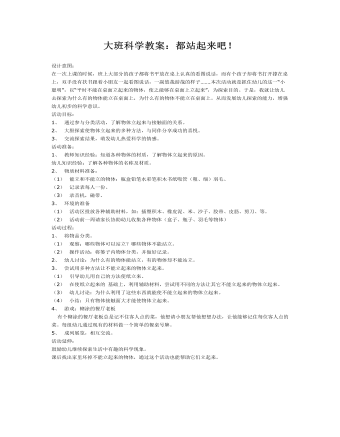
大班科学教案:都站起来吧!
活动目标: 1、 通过参与分类活动,了解物体立起来与接触面的关系。 2、 大胆探索使物体立起来的多种方法,与同伴分享成功的喜悦。 3、 交流探索结果,萌发幼儿热爱科学的情感。 活动准备: 1、 教师知识经验:知道各种物体的材质,了解物体立起来的原因。 幼儿知识经验:了解各种物体的名称及材质。 2、 物质材料准备: (1) 能立和不能立的物体:瓶盒铅笔水彩笔积木书纸吸管(粗、细)羽毛、 (2) 记录表每人一份。 (3) 录音机,磁带。 3、 环境的准备 (1) 活动区投放各种辅助材料,如:插塑积木、橡皮泥、米、沙子、胶带、皮筋、剪刀、等。 (2) 活动前一周请家长协助幼儿收集各种物体(盒子、瓶子、羽毛等物体)
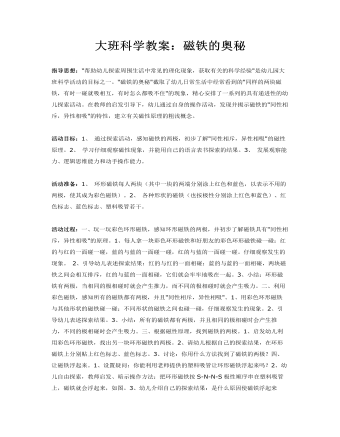
大班科学教案:磁铁的奥秘
活动目标:1、 通过探索活动,感知磁铁的两极,初步了解"同性相斥,异性相吸"的磁性原理。2、 学习仔细观察磁性现象,并能用自己的语言表书探索的结果。3、 发展观察能力、逻辑思维能力和动手操作能力。活动准备:1、 环形磁铁每人两块(其中一块的两端分别涂上红色和蓝色,以表示不用的两极,使其成为彩色磁铁)。2、 各种形状的磁铁(也按极性分别涂上红色和蓝色)、红色标志、蓝色标志、塑料吸管若干。活动过程:一、玩一玩彩色环形磁铁,感知环形磁铁的两极,并初步了解磁铁具有"同性相斥,异性相吸"的原理。1、每人拿一块彩色环形磁铁和好朋友的彩色环形磁铁碰一碰:红的与红的一面碰一碰,蓝的与蓝的一面碰一碰,红的与蓝的一面碰一碰。仔细观察发生的现象。 2、引导幼儿表述探索结果:红的与红的一面相碰;蓝的与蓝的一面相碰,两块磁铁之间会相互排斥,红的与蓝的一面相碰,它们就会牢牢地吸在一起。3、小结:环形磁铁有两极,当相同的极相碰时就会产生推力,而不同的极相碰时就会产生吸力。
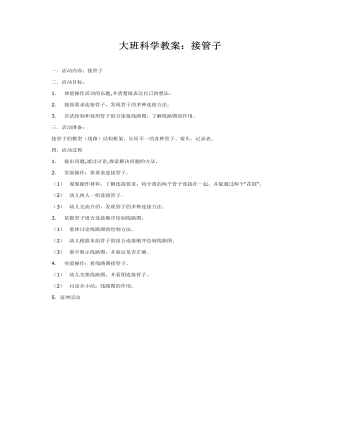
大班科学教案:接管子
二.活动目标: 1. 体验操作活动的乐趣,并清楚地表达自己的想法。 2. 能按要求连接管子,发现管子的多种连接方法。 3. 尝试绘制和使用管子组合连接线路图,了解线路图的作用。 三.活动准备: 接管子的模型(线路)结构框架、长短不一的各种管子、接头、记录表。 四.活动过程 1. 提出问题,通过讨论,探索解决问题的方法。 2. 实验操作:按要求连接管子。

大班科学教案:结网的蜘蛛
活动目标: 1、认识蜘蛛,知道蜘蛛是节肢动物,有吐丝结网的特性。 2、能用科学的态度对待蜘蛛,对蜘蛛不再有害怕和厌恶的情绪。 3、在游戏中培养幼儿丰富的想象力和创造力。 活动准备: 1、课件:各种蜘蛛的幻灯片、蜘蛛结网的动画。 2、彩条、橡皮筋、毛线、幼儿电脑、水彩笔、白纸。 3、在活动室贴上幼儿活动前自己收集的各种蜘蛛的图片。 活动过程: 1、师带幼儿进入活动室,请幼儿观察:今天活动室有什么特别的地方?(让幼儿自由观察贴在墙上的各种蜘蛛的图片)。 2、师告诉幼儿:这些图片都是小朋友们和爸爸、妈妈一起收集的,真能干!今天老师也收集了许多各种各样的蜘蛛图片,请小朋友们来看看。然后展示各种蜘蛛的幻灯片让幼儿观看。 3、师请幼儿讨论: (1)你看到蜘蛛心里有什么感觉? (2)蜘蛛是我们的朋友吗?你喜欢它吗? 4、将幼儿分成两派:喜欢蜘蛛的坐到一边,讨厌蜘蛛的坐到一边。 5、请幼儿分组商量:为什么喜欢(讨厌)蜘蛛?并给自己的小组取名字。
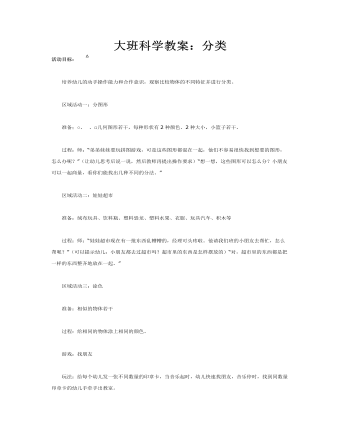
大班科学教案:分类
区域活动一:分图形 准备;○、△、□几何图形若干,每种形状有2种颜色、2种大小,小篮子若干。 过程:师:“弟弟妹妹要玩拼图游戏,可是这些图形都混在一起,他们不容易很快找到想要的图形,怎么办呢?”(让幼儿思考后说一说,然后教师再提出操作要求)“想一想,这些图形可以怎么分?小朋友可以一起商量,看你们能找出几种不同的分法。” 区域活动二:娃娃超市 准备:绒布玩具、饮料瓶、塑料恐龙、塑料水果、衣服、玩具汽车、积木等
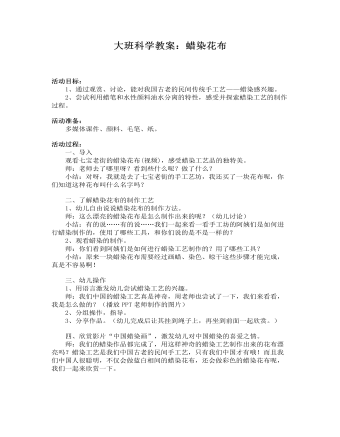
大班科学教案:蜡染花布
活动准备: 多媒体课件、颜料、毛笔、纸。活动过程: 一、导入 观看七宝老街的蜡染花布(视频),感受蜡染工艺品的独特美。 师:老师去了哪里呀?看到些什么呢?做了什么? 小结:对呀,我就是去了七宝老街的手工艺坊,我还买了一块花布呢,你们知道这种花布叫什么名字吗? 二、了解蜡染花布的制作工艺 1、幼儿自由说说蜡染花布的制作方法。 师:这么漂亮的蜡染花布是怎么制作出来的呢?(幼儿讨论) 小结:有的说……有的说……我们一起来看一看手工坊的阿姨们是如何进行蜡染制作的,使用了哪些工具,和你们说的是不是一样的? 2、观看蜡染的制作。 师:你们看到阿姨们是如何进行蜡染工艺制作的?用了哪些工具? 小结:原来一块蜡染花布需要经过画蜡、染色、晾干这些步骤才能完成,真是不容易啊!
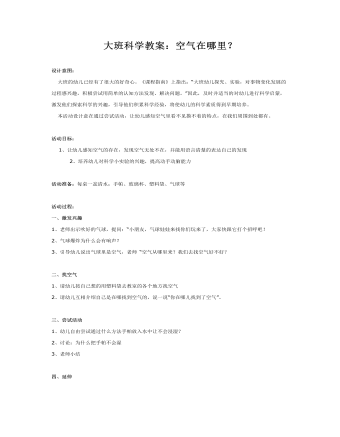
大班科学教案:空气在哪里?
活动目标: 1、让幼儿感知空气的存在,发现空气无处不在,并能用语言清楚的表达自己的发现 2、培养幼儿对科学小实验的兴趣,提高动手动脑能力 活动准备:每桌一盆清水;手帕、玻璃杯、塑料袋、气球等 活动过程:一、激发兴趣1、老师出示吹好的气球,提问:“小朋友,气球娃娃来找你们玩来了,大家快跟它打个招呼吧!2、气球爆炸为什么会有响声?3、引导幼儿说出气球里是空气,老师 “空气从哪里来?我们去找空气好不好?

大班科学教案:浮起的鸡蛋
[活动过程]1.看课件:鸡妈妈买了萝卜、青菜、盐用篮子装好准备回家,发现自己刚下的蛋不见了。鸡妈妈着急的到处找,找呀找,发现鸡蛋掉进一个深深的坑里,鸡妈妈怎么也拿不出来,请小朋友帮鸡妈妈想办法。2.鸡妈妈来到127班,看见老师和小朋友把水和鸡蛋放进罐里,觉得很奇怪。小朋友要借鸡妈妈的盐来用,原来小朋友在做“鸡蛋浮起来了”的实验。3.小朋友把盐放进水里,小心的搅拌,鸡蛋沉到水底还是有什么变化,是沉还是浮,谁的鸡蛋浮起来了。放盐少鸡蛋浮起来吗?有放多少?请他把这个方法和同伴交流,告诉鸡妈妈有个好办法,“把盐放进坑里搅拌,鸡蛋就会浮起来了”。小朋友在小心、细致做着。并用图画、图示、方法培养孩子的记录能力。
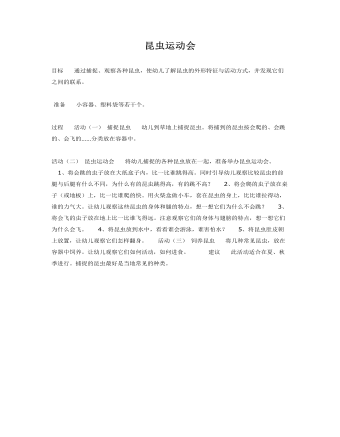
大班科学教案:昆虫运动会
准备 小容器、塑料袋等若干个。 过程 活动(一)捕捉昆虫 幼儿到草地上捕捉昆虫。将捕到的昆虫按会爬的、会跳的、会飞的……分类放在容器中。 活动(二)昆虫运动会 将幼儿捕捉的各种昆虫放在一起,准备举办昆虫运动会。 1、将会跳的虫子放在大纸盒子内,比一比谁跳得高。同时引导幼儿观察比较昆虫的前腿与后腿有什么不同,为什么有的昆虫跳得高,有的跳不高?
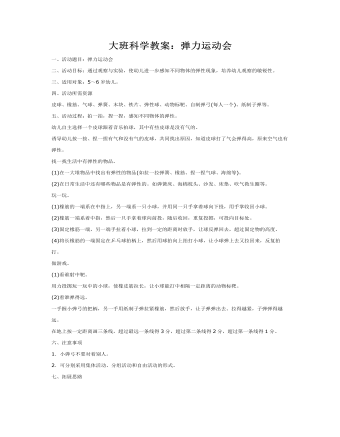
大班科学教案:弹力运动会
二、活动目标:通过观察与实验,使幼儿进一步感知不同物体的弹性现象,培养幼儿观察的敏锐性。三、适用对象:5~6岁幼儿。四、活动所需资源皮球、橡筋、气球、弹簧、木块、铁片、弹性球、动物标靶、自制弹弓(每人一个)、纸制子弹等。五、活动过程:拍一拍,捏一捏,感知不同物体的弹性。幼儿自主选择一个皮球跟着音乐拍球,其中有些皮球是没有气的。诱导幼儿按一按、捏一捏有气和没有气的皮球,共同找出原因,知道皮球打了气会弹得高,原来空气也有弹性。找一找生活中有弹性的物品。(1)在一大堆物品中找出有弹性的物品(如拉一拉弹簧、橡筋、捏一捏气球、海绵等)。(2)在日常生活中还有哪些物品是有弹性的。如弹簧床、海棉枕头、沙发、床垫、吹气救生圈等。玩一玩。(1)橡筋的一端系在中指上,另一端系一只小球,并用同一只手拿着球向下投,用手掌收回小球。(2)橡筋一端系着中指,然后一只手拿着球向前投,随后收回,重复投掷,可投向目标处。(3)固定橡筋一端,另一端手拉着小球,拉到一定的距离时放手,让球反弹回去,超过固定物的高度。(4)将长橡筋的一端固定在乒乓球拍柄上,然后用球拍向上拍打小球,让小球弹上去又拉回来,反复拍打。做游戏。
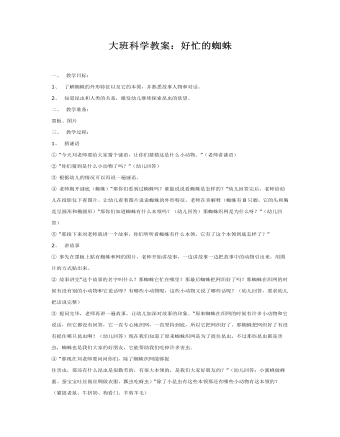
大班科学教案:好忙的蜘蛛
二、 教学准备: 黑板、图片 三、 教学过程: 1、 猜谜语 ① “今天刘老师要给大家猜个谜语,让你们猜猜这是什么小动物。”(老师讲谜语) ② “你们猜到是什么小动物了吗?”(幼儿回答) ③根据幼儿的情况可以再说一遍谜语。 ④老师揭开谜底(蜘蛛)“那你们看到过蜘蛛吗?谁能说说看蜘蛛是怎样的?”幼儿回答完后,老师给幼儿在投影仪下看图片。让幼儿看着图片说说蜘蛛的外形特征。老师在旁解释(蜘蛛有8只脚、它的头和胸是呈圆形和椭圆形)“那你们知道蜘蛛有什么本领吗?(幼儿回答)那蜘蛛织网是为什么呀?”(幼儿回答) ⑤ “那接下来刘老师就讲一个故事,你们听听看蜘蛛有什么本领,它有了这个本领到底怎样了?”
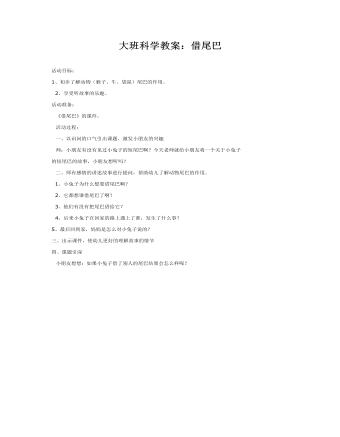
大班科学教案:借尾巴
2、享受听故事的乐趣。活动准备: 《借尾巴》的课件。 活动过程: 一、以讯问的口气引出课题,激发小朋友的兴趣 师:小朋友有没有见过小兔子的短尾巴啊?今天老师就给小朋友将一个关于小兔子的短尾巴的故事,小朋友想听吗? 二、师有感情的讲述故事进行提问,帮助幼儿了解动物尾巴的作用。 1、小兔子为什么想要借尾巴啊?
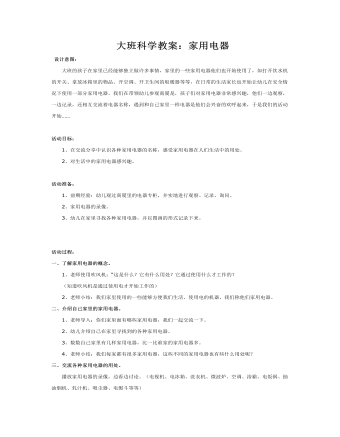
大班科学教案:家用电器
活动目标:1、在交流分享中认识各种家用电器的名称,感受家用电器在人们生活中的用处。2、对生活中的家用电器感兴趣。 活动准备:1、前期经验:幼儿观过商厦里的电器专柜,并实地进行观察、记录、询问。2、家用电器的录像。3、幼儿在家里寻找各种家用电器,并以图画的形式记录下来。 活动过程:一、了解家用电器的概念。1、老师使用吹风机:“这是什么?它有什么用处?它通过使用什么才工作的? (知道吹风机是通过使用电才开始工作的)2、老师小结:我们家里使用的一些能够方便我们生活、使用电的机器,我们称他们家用电器。二、介绍自己家里的家用电器。1、老师导入:你们家里面有哪些家用电器,我们一起交流一下。2、幼儿介绍自己在家里寻找到的各种家用电器。3、数数自己家里有几样家用电器,比一比谁家的家用电器多。4、老师小结:我们每家都有很多家用电器,这些不同的家用电器也有些什么用处呢?三、交流各种家用电器的用处。 播放家用电器的录像,边看边讨论。(电视机、电冰箱、洗衣机、微波炉、空调、浴霸、电饭锅、抽油烟机、轧汁机、吸尘器、电熨斗等等)1、这是什么?有什么用处?2、它们的形状、颜色一样吗?为什么要不一样?(满足人们不同的喜好)3、随机提问:你同意他的说法吗?还有什么意见?4、你们还有什么问题吗?可以提出来大家一起讨论?5、老师小结:家用电器用处可真大,它们给我们生活带来了方便。
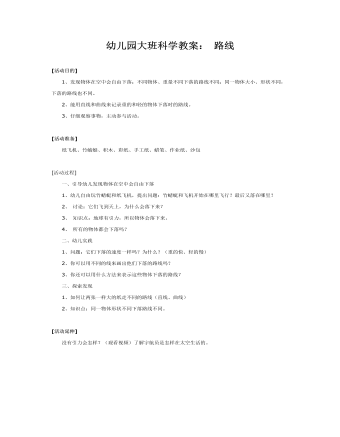
幼儿园大班科学教案: 路线
[活动准备] 纸飞机、竹蜻蜓、积木、彩纸、手工纸、蜡笔、作业纸、沙包 [活动过程] 一、引导幼儿发现物体在空中会自由下落1、幼儿自由玩竹蜻蜓和纸飞机,提出问题:竹蜻蜓和飞机开始在哪里飞行?最后又落在哪里?2、讨论:它们飞到天上,为什么会落下来?3、知识点:地球有引力,所以物体会落下来。4、所有的物体都会下落吗?

小班科学教案 挖土大力士
【活动准备】1、活动开展前教师和家长应带幼儿观察建筑工地。2、准备各种挖土工具的图书、图片、录像等资料。3、收集玩具挖土机。 【活动过程】1、导入:小朋友,你们见过挖土机吗?谁能说一说挖土机有什么本领?2、观看录象:在各种不同场所工作着的挖土机。 (1)请幼儿仔细观察挖土机是怎样工作的。 (2)请幼儿观察挖土机用什么挖土?像什么? (3)让幼儿学着挖土机按顺序作挖土的动作。 (4)引导幼儿用语言描述挖土机的样子以及它挖土的动作。

新人教版高中英语必修3Unit 2 Morals and Virtues教学设计三
The joke set her crying.这个玩笑使她哭起来。Step 5 ReadingActivity 31. Students read the small text in activity 3. The teacher provides several small questions to check whether students understand the content of the text and the ideographic function of the -ing form in the text.*Where are those people?*Why did Dr Bethune come to China?*How did he help the Chinese people during the war?*What did Chairman Mao Zedong say about him?2. Ss try to rewrite some sentences using the -ing form. Then check the answers. When checking the answers, the teacher can ask different students to read the rewritten sentences and give comments.Answers:1. he became very interested in medicine, deciding to become a doctor.2. …after hearing that many people were dying in the war.3. Helping to organise hospitals, he taught doctors and nurses, and showed people how to give first aid./ He helped to organise hospitals, teaching doctors and nurses, and showing people how to give first aid.4. …praising Dr Bethune as a hero to be remembered in China.Step 6 PracticeActivity 4Students complete grammar activities 2 and 3 on page 69 of the workbook.Step 6 Homework1. Understand and master the functions and usage of the -ing form;2. Finish the other exercises in Using structures.1、通过本节内容学习,学生是否理解和掌握动词-ing形式作宾语补足语语和状语语的功能和意义;2、通过本节内容学习,学生能否正确使用动词-ing形式描述人物的行为、动作及其经历;3、通过本节内容学习,学生能否独立完成练习册和导学案中的相关练习。

新人教版高中英语必修3Unit 2 Morals and Virtues教学设计二
Activity 41. Students complete the task of activity 4, then teachers and students check the answers. 2. The teacher organized the students to work together and asked them to use the tables and mind maps sorted out before to retold the important choices in Lin Qiaozhi's life and their resultsStep 5 Language points1. The teacher asks the students to read the text carefully, find out the core words and long and difficult sentences in the text and draw lines, understand the use of vocabulary, and analyze the structure of long and difficult sentences. 2. The teacher explains and summarizes the usage of core vocabulary and asks the students to take notes. 3. The teacher analyzes and explains the long and difficult sentences that the students don't understand, so that the students can understand them better. Step 6 Homework1. Read the text again, in-depth understanding of the text; 2. Master the use of core vocabulary and understand the long and difficult sentences. 3. Complete relevant exercises in the guide plan. 1、通过本节内容学习,学生是否理解和掌握阅读文本中的新词汇的意义与用法;2、通过本节内容学习,学生能否结合文本特点总结林巧稚的人生原则和人格品质特征;3、通过本节内容学习,学生能否针对人生抉择发表自己的看法;能否全面地、客观地、理性地看待问题,进而对道德和人性有更加深入的思考和理解。

新人教版高中英语必修3Unit 2 Morals and Virtues教学设计四
3.Teachers ask different groups to report the answers to the questions and ask them to try different sentence patterns.The teacher added some sentence patterns for students to refer to when writing.Step 4 Writing taskActivity 51.Write the first draft.Students first review the evaluation criteria in activity 5, and then independently complete the draft according to the outline of activity 4, the answers to the questions listed in the group discussion and report, and the reference sentence pattern.2.Change partners.The teacher guides the students to evaluate their partner's composition according to the checklist of activity 5 and proposes Suggestions for modification.3.Finalize the draft.Based on the peer evaluation, students revise their own compositions and determine the final draft.Finally, through group recommendation, the teacher selects excellent compositions for projection display or reading aloud in class, and gives comments and Suggestions.Step 5 Showing writingActivity 5T call some Ss to share their writing.Step 6 Homework1. Read the passage in this section to better understand the passage.2. Carefully understand the hierarchical structure of the article, and deeply understand the plot of the story according to the causes, process and results;3. Independently complete the relevant exercises in the guide plan.1、通过本节内容学习,学生是否理解和掌握阅读文本中的新词汇的意义与用法;2、通过本节内容学习,学生能否通过人物言行的对比分析道德故事的深层内涵;3、通过本节内容学习,学生能否根据故事的起因、经过和结果来深入理解故事的情节,从而了解文章的层次结构;4、结合现实生活案例发表自己的见解和看法,写一篇观点明确、层次分明的故事评论。

新人教版高中英语必修3Unit 2 Morals and virtues教学设计一
(2) students are divided into groups according to the requirements of activity 3. Each student shares a story of personal experience or hearing-witnessing kindness, and then selects the most touching story in the group and shares it with the whole class. Before the students share the story, the teacher can instruct them to use the words and sentence patterns in the box to express. For example, the words in the box can be classified:Time order: first of all, then, after that, later, finally logical relationship :so, however, although, butTeachers can also appropriately add some transitional language to enrich students' expression:Afterwards, afterwards, at last, in the end, eventuallySpatial order: next to, far from, on the left, in front ofOtherwise, nevertheless, as a result, therefore, furthermore, in addition, as well asSummary: in a word, in short, on the whole, to sum up, in briefStep 8 Homework1. Understand the definition of "moral dilemma" and establish a correct moral view;2. Accumulate vocabulary about attitudes and emotions in listening texts and use them to express your own views;3. Complete relevant exercises in the guide plan.1、通过本节内容学习,学生能否理解理解“道德困境”的定义;2、通过本节内容学习,学生能否通过说话人所表达的内容、说话的语气、语调等来判断其态度和情绪;3、通过本节内容学习,学生能否针对具体的道德困境发表自己的看法和见解,能否掌握听力理训练中的听力策略。

新人教版高中英语选修2Unit 4 Reading and thinking教学设计
【词汇精讲】highlight n.最好或最精彩的部分 vt.突出;强调;使醒目One of the highlights of the trip was seeing the Taj Mahal.这次旅行的亮点之一是参观泰姬陵。Your resume should highlight your skills and achievements.你的简历应该突出你的技能和成就。The report highlights the major problems facing society today.报告强调了当今社会所面临的主要问题。I’ve highlighted the important passages in yellow.我用黄色标出了重要段落。7.Edmonton is freezing cold in winter,with daily temperatures averaging -10 ℃.埃德蒙顿冬季寒冷,日平均气温为-10°C。【词汇精讲】freezing adj.极冷的;冰冻的Leave a basin of water outside in freezing weather.在冰冻的天气里,放一盆水在室外。It’s freezing cold outside so wear a warm coat.外面超冷的,所以穿一个暖和一点的外套吧。8.It was not until 9:30 a.m.that they finally reached the capital of Ontario,Toronto.直到上午9时30分,他们才终于到达多伦多的首府安大略省。【句式剖析】本句是一个强调句,强调的是句子的时间状语until 9:30。含有not...until...的句子的强调句为It is not until...that...,that后面的句子要用肯定形式。It was not until then that I suddenly realized nobody was happier than I was.直到那时我才突然意识到没有人比我更幸福了。

